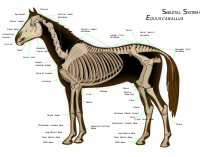
Photo from wikipedia
OBJECTIVE We sought to assess the effectiveness of 12 weeks of a physical exercise program (PEP) in child rugby players with lower-limb overpronation during gait. METHODS This was a randomized… Click to show full abstract
OBJECTIVE We sought to assess the effectiveness of 12 weeks of a physical exercise program (PEP) in child rugby players with lower-limb overpronation during gait. METHODS This was a randomized clinical trial. A total of 123 young athletes (mean ± standard deviation age, 10.35 ± 1.22 years) were evaluated, 20 of whom had lower-limb overpronation (n = 40 extremities). Participants were randomly assigned to 2 groups: the experimental group, who performed their normal training and a PEP for 12 weeks, and the control group, who continued with their normal training for the same time. The PEP was focused on stretching the hypertonic muscle and potentiating the weakened muscles of the lower body. All participants underwent biomechanical analysis including the Helbing angle, the femorotibial angle, and the Fick angle in both limbs. RESULTS All participants (n = 20) completed the study. Baseline measurements showed no significant differences between groups in any of the variables tested. After 12 weeks, there were significant differences between groups (P < .001 for all angles). No improvement was found in the control group; however, meaningful improvement was found in all variables in the experimental group: Helbing angle (175°, P < .001, effect size [ES] = 1.94), femorotibial angle (173°, P < .001, ES = 1.77), Fick angle (12°, P < .001, ES = 1.55). The number needed to treat was 2 for femorotibial angle and Helbing angle, and 3 for Fick angle. CONCLUSION A 12-week PEP produced significant improvements in these 3 biomechanical variables. We also conclude that young athletes with a pathological gait pattern reached a normal gait pattern.
Journal Title: Journal of manipulative and physiological therapeutics
Year Published: 2020
Link to full text (if available)
Share on Social Media: Sign Up to like & get
recommendations!